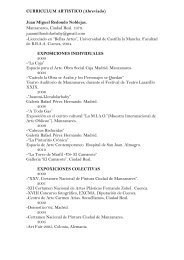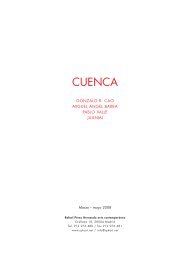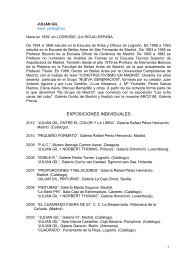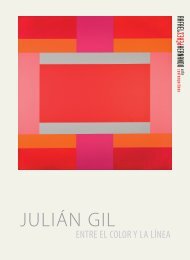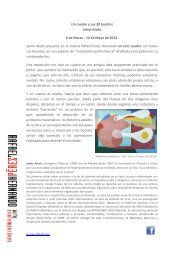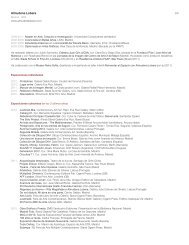JULIÁN GIL: PENSAMIENTO SISTÉMICO – SISTEMAS DINÁMICOSSeries PHI, RA (Relaciones Áureas) y PAC (Proporciones Áureas Cuadrado)La necesidad de reducir en pocas palabras el mundo complejo de Julián Gil, de una granriqueza de lenguaje gráfico y conceptual me obliga a acotar el territorio de lo que quierocompartir y a elegir un punto de vista que me permita ir un poco más allá de lo que a primeravista pudiera parecer evidente. Mi aproximación a su mundo es desde la autoría, laobra y el proceso. Del autor, el pensamiento sistémico. De la obra, los sistemas dinámicos.Y del proceso, el estudio de las series PHI, RA y PAC que presenta en esta exposición.La herramienta más útil para pensar las obras de Julián Gil son los sistemas. Los sistemasson un conjunto de conceptos, herramientas y variables, previos a la realización dela obra, que maneja a modo de bocetos y que le sirven para experimentar, aprender y comprenderlas posibilidades del propio sistema. Cada sistema genera una o más series deobras numeradas que están clasificadas por nombres y que anticipan al espectador lasreglas del juego que rigen las obras: serie ORTogonal, serie ESCuadra, HEMipitagórica,ORT + ESC, ORT + HEM, ESC + HEM, ORT + ESC + HEM, Raízdedos, Tondos, PHI,RA, PAC y sistema cromático de 64 colores basado en el cubo de los colores de AlfredHickethier.Julián Gil maneja expectativas, se propone metas, escoge medios... Sus sistemas son elresultado de observar, ordenar y estructurar un mundo de conocimientos y experienciaspersonales. Al observar, realiza un conjunto coherente de elecciones; se concentra en cosasconcretas; crea límites.Al ordenar, determina con exactitud cuáles son los métodos que conforman el sistema.Es decir, qué operaciones utiliza para construir las estructuras necesarias dentro del sistemay qué directrices debe seguir para determinar cada uno de los estados por los que debepasar la obra para alcanzar un resultado satisfactorio.Al estructurar, busca un orden en su trabajo. Descubre las leyes estructurales y cromáticasque rigen sus obras. Hace que el código utilizado se haga visible. Construye retículascomplejas que le aporten un repertorio grande de posibilidades para poder elegir las líneasestructurales más oportunas que sirvan para generar su obra. Las líneas estructuralesJULIÁN GIL: SYSTEMIC THOUGHT – DYNAMIC SYSTEMSSeries PHI, RA (Golden Ratio) and PAC (Golden SquareProportions)The need to reduce to some few words the complex world of JuliánGil, one of great richness in graphic and conceptual language, forcesme to limit the territory I wish to share and to choose a viewpointthat allows me to go beyond what at first sight may seem evident.My approach to his world concerns creator, the work and theprocess. From the creator, systemic thought. From the work, dynamicsystems. And from the process, the study of the series PHI, RAand PAC, shown in this exhibition.The most useful tool for thinking about the works of Julián Gilare the systems. The systems are a set of concepts, tools and variables,prior to the realization of the work, which he uses as sketchesand which assist him in experimenting, learning and understandingthe possibilities of the system itself. Each system produces oneor more series of numbered works that are classified by names andtell the observer in advance about the rules of the game that governsthe works: series ORTogonal, series ESCuadra, HEMipitagórica,ORT + ESC, ORT + HEM, ESC + HEM, ORT + ESC + HEM,Raízdedos, Tondos, PHI, RA, PAC and the chromatic system of 64colours based on Alfred Hickethier’s colour cube.Julián Gil plays with expectations, sets goals, choosesmedia... His systems are the results of observation, ordering andstructuring a world of knowledge and personal experience. Whenhe observes, he makes a coherent set of choices; he concentrateson concrete things; he creates limits.When he orders, he precisely determines which methods conformto the system. That is, what operations he will use to build thenecessary structures inside the system and what guidelines he must5
elegidas reflejan un orden y permiten una división lógica y formal de la superficie. En algunoscasos, el orden que contienen se hace palpable porque existe una gran similitud entre elformato del cuadro y las líneas estructurales elegidas (serie RA). En otros casos, es la superposiciónde la retícula sobre la superficie del cuadro la que asegura la unificación de todaslas partes del cuadro. En cualquier caso, se trata de encontrar un orden no jerárquico quepermita que ningún área generada sea preferida o prioritaria sobre las otras.Julián Gil, según las necesidades expresivas personales que cada serie de obras requiere,establece relaciones entre los colores según criterios muy diferentes. Unas veces utilizaun número determinado de parejas de colores complementarios. Otras veces, la elecciónde una gama cromática se debe a las posiciones simétricas o a los ritmos geométricos delos colores seleccionados dentro del cubo de Hickethier. La elección de los colores se puededeber también a que sean colores con el mismo grado de saturación, con la misma cantidadde uno de sus componentes en la mezcla, o con distinto grado de luminosidad. Se utilizantambién gradaciones uniformes, progresiones y combinación de escalas monocromaso policromas con y sin grises. A veces incluso realiza una selección aleatoria de los colores,o corrige algunas de las familias seleccionadas hasta que ajusta el resultado cromáticoa unas necesidades organizativas establecidas previamente.El número de colores en cada serie está determinado por el tema. Julián Gil, según laestrategia de color que elige en cada situación, obtiene un número determinado de combinacionescromáticas posibles. En una serie en que cada una de las obras va a utilizar 4tonos, obtiene 16 combinaciones posibles (16 x 4 = 64) si no repite ninguno de los tonosen la serie. Si la repetición de tonos se permite, el número de posibilidades aumenta.Colores y estructuras no son, para Julián Gil, sistemas dinámicos simétricos, sino que,cada uno con sus propias características y su propia riqueza organizativa complementa alotro para establecer un orden a sus obras que satisfaga sus necesidades expresivas.La obra de Julián Gil refleja una economía de vocabulario, un control de la sintaxis:determinación matemática de los formatos, relación entre las formas y las leyes numéricas,especificación de los colores. Se ponen en evidencia problemas de proporción, llenosy vacíos, regularidad, cadencia, número, tensión, color. La simplicidad, reducción de complejidad,que se da en su obra no es producto de lo espontáneo sino de una continua revisiónreflexiva y, en caso de que sea oportuno, modificación, de los sistemas que utiliza paradesarrollar su obra.follow to determine every state the work has to pass through toattain a satisfactory result.When he structures, he searches for order in his work. Hefinds out the structural and chromatic laws that are to govern hisworks. He makes the code being used visible. He constructs complexnetworks that give him a large repertoire of possibilities inorder to be able to choose the most suitable structural lines to producehis work. The chosen structural lines reflect an order and permita logical and formal division of the surface. In some cases, theirorder is palpable due to a strong similarity between the format ofthe picture and the chosen structural lines (series RA). In othercases, it is the superimposition of the grid on the surface of the picturethat ensures the unification of all the parts of the picture. Inany case, the aim is to find a non-hierarchical order that does notpermit any area to have preference or priority over the others.Julián Gil, according to the personal expressive necessitiesthat each series of works requires, establishes relationshipsbetween the colours according to very different criteria. Sometimeshe uses a specific number of pairs of complementary colours. Othertimes, the choice of chromatic range is based on symmetrical positionsor the geometric rhythms of the colours selected within theHickethier cube. The choice of colours can also be arrived atbecause they have the same degree of saturation, with the sameamount of one of the components in the mix, or a different degreeof luminosity. Also used are uniform gradations, progressions and acombination of monochrome and polychrome ranges with and withoutgreys. Sometimes he even makes a random selection ofcolours, or corrects some of the families selected until the chromaticresult adjusts to previously established organizational necessities.The number of colours in each series is determined by the subject.Julián Gil, in keeping with the colour strategy he chooses ineach situation, obtains a specific number of possible chromatic com-6
- Page 2 and 3: JULIÁN GIL
- Page 4 and 5: JULIÁN GILPROPORCIONES Y RELACIONE
- Page 8 and 9: Julián Gil presenta en esta exposi
- Page 10 and 11: pias subdivisiones PHI del rectáng
- Page 12 and 13: por los tonos 390, 690, 990; y la s
- Page 14 and 15: de las siguientes formas: en un cua
- Page 16 and 17: En la serie PAC 4-12 una retícula
- Page 18 and 19: OBRAS EN CATÁLOGO
- Page 20 and 21: PHI 030B, 2004. Acrílico sobre tel
- Page 22 and 23: ÁUREO FA 02, 2006. Acrílico sobre
- Page 24 and 25: ÁUREO FB 01, 2004. Acrílico sobre
- Page 26 and 27: ÁUREO FJ 01, 2006. Acrílico sobre
- Page 28 and 29: PAC 5 05 C, 2006. Acrílico sobre t
- Page 30 and 31: PAC 7 02 C, 2006. Acrílico sobre t
- Page 32 and 33: PAC 3 04 A, 2005. Acrílico sobre t
- Page 34 and 35: PAC 4 14 A, 2005. Acrílico sobre t
- Page 36 and 37: PAC 5 01 C, 2005. Acrílico sobre t
- Page 38 and 39: PAC 5 09 C, 2005. Acrílico sobre t
- Page 40 and 41: PAC 4 12 APAC 4 12 EPAC 4 12 IPAC 4
- Page 42 and 43: JULIÁN GILwww.juliangil.euNace en
- Page 44 and 45: «CONSTRUCTIVE ART IN EUROPE AT THE
- Page 46: ESTE CATÁLOGO DEJULIÁN GILSE TERM




